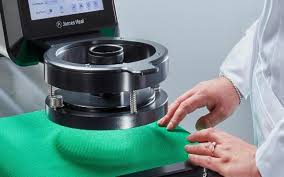The Hydrostatic Head Tester: Understanding Water Resistance in Fabrics

The Hydrostatic Head Tester is an essential instrument in the textile industry, used to measure the water resistance of fabrics. With the growing demand for high-performance textiles in outdoor clothing, sportswear, and functional fabrics, understanding the water resistance properties of materials has become increasingly important. This essay will explore the function of the Hydrostatic Head Tester, how it works, its applications, and its significance in the textile industry.
What is a Hydrostatic Head Tester?
A Hydrostatic Head Tester is a device designed to determine the ability of a fabric to resist water penetration under pressure. The term “hydrostatic head” refers to the height of a column of water that a fabric can withstand before water starts to leak through. It is measured in millimeters (mm) and serves as a standard for evaluating water resistance in textiles.
The test involves placing a fabric sample under a column of water and gradually increasing the pressure until the fabric begins to leak. The height of the water column at the point where the fabric first leaks is recorded as the fabric’s hydrostatic head value. A higher hydrostatic head value indicates better water resistance, which is crucial for fabrics used in outdoor wear or protective clothing.
Read More About : Textile Testing Machine-TESTEX
How Does the Hydrostatic Head Tester Work?
The Hydrostatic Head Tester consists of several components, including a water tank, a pressure regulator, and a device for measuring the height of the water column. The fabric sample is typically placed on a rigid platform, and water is slowly introduced onto the surface of the fabric. As the water pressure increases, the tester monitors when the first drop of water penetrates through the fabric.
The key aspect of the test is the application of water pressure, which simulates real-life conditions, such as rain, snow, or moisture from various sources. This method differs from other forms of water resistance testing, such as spray tests, because it evaluates the fabric’s ability to withstand water under continuous pressure, a critical factor in outdoor and functional apparel.
The Importance of Hydrostatic Head Testing
Hydrostatic Head testing is vital for a variety of reasons, especially for manufacturers and consumers of performance fabrics. The main applications of this test include:
- Outdoor Apparel: Fabrics used in rain jackets, tents, and outdoor gear need to have high hydrostatic head values to ensure they provide adequate protection against the elements. Without this test, manufacturers may not know if their products will perform effectively under real-world conditions.
- Sportswear and Activewear: Athletes, particularly those involved in water sports or extreme weather conditions, rely on high-performance fabrics that can resist water infiltration while maintaining breathability and comfort. Hydrostatic Head testing helps manufacturers design garments that balance water resistance with moisture management.
- Military and Protective Gear: Protective clothing for soldiers, firefighters, or workers in hazardous environments must have sufficient water resistance to prevent external moisture from entering. Hydrostatic Head values are used to determine whether the fabric can provide adequate protection during prolonged exposure to wet conditions.
- Product Quality Assurance: For textile manufacturers, the Hydrostatic Head Tester is a crucial part of quality control. It ensures that the fabric used in commercial products meets the required standards for water resistance. This process helps maintain product integrity and enhances customer satisfaction.
For more information about hydrostatic testing equipment
Standardization of Hydrostatic Head Testing
As with many other tests in the textile industry, Hydrostatic Head testing is governed by international standards to ensure uniformity and reliability of results. One of the most widely accepted standards is the ISO 811 test method, which outlines the procedure for determining water resistance in fabrics. These standardized procedures allow manufacturers to compare the performance of different fabrics under consistent conditions, providing valuable data for product development.
Furthermore, different industries and applications require different levels of water resistance. For example, a standard raincoat may have a hydrostatic head value of 1,500 mm, while high-performance outdoor gear may require a value of 10,000 mm or more. By adhering to standardized test procedures, manufacturers can meet specific market demands for various levels of water resistance.
Limitations and Challenges
While the Hydrostatic Head Tester is a widely used and effective tool for assessing water resistance, it does have its limitations. For example, the test only evaluates resistance under pressure, not the fabric’s ability to handle other factors such as wind, UV exposure, or abrasion, all of which can impact the performance of outdoor fabrics. Additionally, the test is done under static conditions, whereas in real-life situations, fabrics are subjected to dynamic forces, such as movement, stretching, and bending.
Moreover, the test does not account for long-term wear and tear. A fabric that passes the Hydrostatic Head test may still lose its water resistance over time due to exposure to repeated washing, friction, or aging. Therefore, manufacturers often perform additional tests to evaluate how fabrics hold up after prolonged use.
Conclusion
In conclusion, the Hydrostatic Head Tester is an essential tool in the textile industry for measuring the water resistance of fabrics. It plays a crucial role in ensuring the quality and functionality of textiles used in outdoor apparel, sportswear, and protective gear. While the test provides valuable insights into a fabric’s performance under water pressure, it is just one part of a broader quality assurance process. With the continuous development of new materials and testing methods, the Hydrostatic Head Tester will remain an integral part of the textile industry’s commitment to creating high-performance fabrics that meet the demands of consumers in various environments.
For more information on textile testing methods/standards
or textile testing machines, contact us:
What’s App: +86 180 2511 4082
Tel: +86 769 2329 4842
Fax: +86 769 2329 4860
Email: sales@chiuvention.com sales@tes.hk



